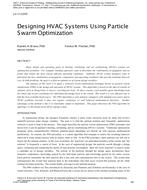Description
Many design and operating goals in heating, ventilating, and air conditioning (HVAC) systems are optimization problems. For example, building operators want to determine the combination of equipment and set points that obtain the most energy efficient operating conditions. Similarly, HVAC system designers want to determine the best combination of equipment, components and operating conditions that provide minimum lifecycle cost. In both problems, the goal is to find an optimal set of system design variables.
The purpose of this work is to apply a relatively recent optimization technique known as particle swarm optimization (PSO) to the design and operation of HVAC systems. This algorithm is based on the idea of swarms of animals, such as flying birds or insects, searching for food. In these swarms, each member gains knowledge from the whole and in turn contributes his individual knowledge back to the swarm. The result is a very efficient way to find the best available food source. The PSO algorithm is well suited to computers with multiple processors and to HVAC problems because it does not require continuous or well behaved mathematical functions. Another advantage of the method is that it is remarkably simple to implement. This paper illustrates the PSO algorithm by applying it to the design of an HVAC piping system.
Citation: ASHRAE Conference Papers, Las Vegas, NV
Product Details
- Published:
- 2011
- Number of Pages:
- 14
- File Size:
- 1 file , 2.5 MB
- Product Code(s):
- D-LV-11-C070




